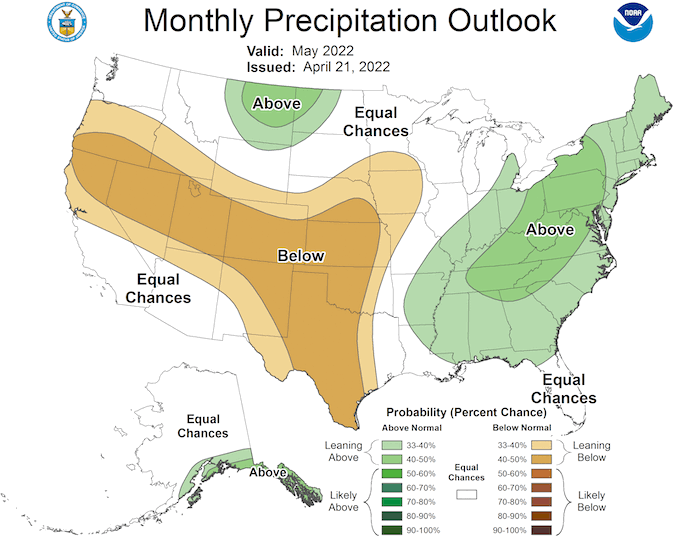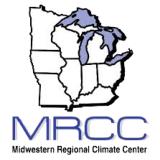Recent Improvement in Drought Conditions Across the Midwest.
Key Points
- Significant spring-time precipitation removed lingering drought concerns for most areas of the Upper Midwest that have been experiencing drought conditions since summer into the fall of 2021.
- Currently, only 2% of the region is impacted by drought, which is confined to western Iowa. While Iowa has recently seen some drought relief, moderate drought (D1) is still affecting 13% of the state, with severe drought (D2) affecting 2%.
- Current impacts include below-normal streamflow, limited shallow groundwater supplies, and dry soils in western Iowa.
- The region has been in a wet pattern recently, which could mean further improvement to drought conditions in the short term.
- However, the seasonal outlooks for May through July 2022 show a greater chance for hotter and drier conditions in the western portions of the Midwest, which is expected to lead to drought persistence in western Iowa, and could potentially lead to drought development across a majority of Iowa, as well as southern Minnesota and northern Missouri.
Current U.S. Drought Monitor map for the Midwest Drought Early Warning System (DEWS) with data valid for April 26, 2022. The U.S. Drought Monitor (USDM) is updated each Thursday to show the location and intensity of drought across the country. Drought categories show experts’ assessments of conditions related to dryness and drought including observations of how much water is available in streams, lakes, and soils compared to usual for the same time of year.
U.S. Drought Monitor Categories
Current U.S. Drought Monitor map for the Midwest Drought Early Warning System (DEWS) with data valid for April 26, 2022. The U.S. Drought Monitor (USDM) is updated each Thursday to show the location and intensity of drought across the country. Drought categories show experts’ assessments of conditions related to dryness and drought including observations of how much water is available in streams, lakes, and soils compared to usual for the same time of year.
Current Conditions
- Significant springtime precipitation removed lingering drought concerns for many areas of the Upper Midwest that have been experiencing drought conditions since summer into the fall of 2021.
- Currently, only 2% of the region is impacted by drought, which is confined to western Iowa. While Iowa has recently seen some drought relief, moderate drought (D1) is still affecting 13% of the state, with severe drought (D2) affecting 2%.
- Over the last 8 weeks, many areas across the Upper Midwest improved by one to three categories on the U.S. Drought Monitor (Figure 1). Drought has been a concern for northern Illinois, southern Wisconsin, and eastern Iowa since April 2021, and these areas finally received much-needed precipitation to alleviate long-term drought concerns and impacts.
- Precipitation since March 1 has been near- to above-normal across a majority of the Midwest. Precipitation ranged from 150%–300% of normal across the Upper Midwest. However, some areas did receive only 25%–75% of normal precipitation, including western Iowa, southern Minnesota, and portions of the Ohio River basin (Figure 2).
Figure 1. 8-Week U.S. Drought Monitor Change Map (Since March 1, 2022)

Figure 2. Percent of Normal Precipitation (%) Since March 1, 2022

Impacts
- As expected with above-normal precipitation, streamflows across the Midwest region are near- to above-normal (Figure 3). However, some areas in western and northern Iowa are showing below-normal flow levels. Portions of the Des Moines, Cedar, Upper Iowa, Raccoon, Nishnabotna, Floyd, Boyer, Little Sioux, and Soldier Rivers have moved into below-normal conditions.
- Shallow groundwater supplies are causing some concern in western Iowa (Figure 4). Water supply staff in western Iowa are saying shallow wells for supply are as low as they’ve ever been. Northern Illinois is also experiencing some lingering groundwater issues as well.
- Overall, current groundwater impacts in Iowa are likely relatively minor. However, if drought conditions develop or intensify, these areas may be vulnerable to declining shallow groundwater levels and reduced aquifer recharge.
- Soil moisture is near- to above-normal across the region, with pockets of below-normal soil moisture in Iowa and southern Minnesota and some lingering dryness in northern Illinois and southern Wisconsin (Figure 5).
Report your drought impacts through the Condition Monitoring Observer Reports (CMOR):
Figure 3. U.S. Geological Survey Streamflow Percentiles – Ending April 28, 2022

Figure 4. Iowa Shallow Groundwater Conditions for March 2022

Figure 5. Past Week Top 1-Meter Soil Moisture Percentile (Valid April 23, 2022)

Outlook and Potential Impacts
- As we move into early May, precipitation from May 6–12 is expected to be below normal across the Great Lakes region, with near-normal precipitation or above-normal precipitation elsewhere (Figure 6).
- The precipitation outlook for May shows greater chances for above-normal precipitation in the Ohio River Basin, with greater chances for below-normal precipitation in the areas currently experiencing drought (western Iowa) (Figure 7). Temperatures are likely to be below-normal across the region in May.
- The region has been in a wet pattern recently, which could mean further improvement to drought conditions in the short term.
- However, the seasonal outlooks for May through July 2022 show a greater chance for hotter and drier conditions in the western portions of the Midwest, which is expected to lead to drought persistence in western Iowa, and could potentially lead to drought development across a majority of Iowa, as well as southern Minnesota and northern Missouri (Figure 8).
- Potential impacts include intensification of reduced streamflows and shallow groundwater issues across Iowa, and inadequate moisture for crop growth during the growing season on non-irrigated areas.
Figure 6. Precipitation Outlook for May 6–12, 2022

Figure 7. Monthly Precipitation Outlook for May 2022

Figure 8. U.S. Seasonal Drought Outlook for April 21–July 31, 2022

For More Information
- NIDIS and its partners will issue future updates as conditions evolve.
- For more details on current conditions, view the April 21 North Central Climate and Drought Outlook Webinar.
- More local information is available from the following resources:
- Your state climatologist
- Your local National Weather Service office
- For more information on Iowa, visit their Water Summary Update page.
- To report or view local drought impact information:
- Report your drought impacts through Condition Monitoring Observer Reports (CMOR)
- To view or submit reports in Montana, visit the Montana Drought Impact Reporter.
- View CoCoRaHS Condition Monitoring reports.
- The upcoming North Central U.S. Climate and Drought Summary & Outlook Webinar on May 19, 2022 will offer updated information about conditions, impacts, and outlooks.
Prepared By
Molly Woloszyn
NOAA/National Integrated Drought Information System (NIDIS)
Dennis Todey & Laurie Nowatzke
USDA Midwest Climate Hub
Doug Kluck
NOAA/National Centers for Environmental Information
Melissa Widhalm
Midwestern Regional Climate Center/Purdue University
Ray Wolf & Audra Bruschi
NOAA/National Weather Service
This drought status update is issued in partnership between the National Oceanic and Atmospheric Administration (NOAA) and the U.S. Department of Agriculture (USDA) to communicate a potential area of concern for drought expansion and/or development within the Midwest U.S. based on recent conditions and the upcoming forecast. NIDIS and its partners will issue future drought status updates as conditions evolve.








